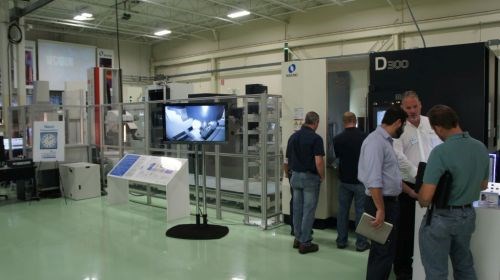Preparing to Automate
One of the many presentations at Makino's recent Technology Expo covered die/mold automation. Here are a few takeaways on things to think about early in any implementation.

A robot feeds the Inifinite Focus G5, just one of many noncontact mesaurement solutions from Alicona showcased at the event. Many of these systems were integrated directly with milling and EDM machines.
Automation can get complicated, particularly for a toolmaker.
That's likely not news to most readers of this blog, and it probably also explains the heavy attendance at a presentation on that topic at Makino's recent Technology Expo event September 16-17 in Auburn Hills, Michigan. Indeed, presenter John Bradford took every opportunity to emphasize the importance of involving a knowledgeable partner at the outset of any new automation effort, particularly for toolmaking operations that rarely deal with repeat work. Even assembly-line-style, high-production implementations differ widely from company to company. A supplier like Makino offers a breadth of experience that can help avoid unexpected problems and delays, he says.
Although I couldn't hope to cover the entirety Bradford's wide-ranging presentation here, below are a few takeaways related to strategies companies can employ early in the process to ensure smooth implementation. Meanwhile, check out this slideshow for a look at a few newer developments in CNC technology.
Set specific goals. Before you start, have an idea of where you want to go. After all, the more complex the task, the more difficult it is to automate cost-effectively, Bradford says. When the goal is to reduce labor without increasing costs or creating new problems in the process Processes like polishing, deburring, assembly present a far greater challenge than, say, changing tools, he explains. So, it may be best to start small. Other considerations include part size (which dictates the size of pallets, robots, storage units and so forth) and machine utilization (Bradford recommends automating the most oft-used machines, adding that automation is often justified even if setup time pales in comparison to machining time).
Get off the machine. An operation where employees aren't comfortable with pushing "cycle start" and walking away is likely not prepared for any significant degree of automation, Bradford says. The case is the same if existing automation—automatic tool changers, for example—aren't being used. Moving programming and setup offline is another wise step to take before taking the plunge. This strategy, along with technology like tool presetters, can go a long way toward reducing what Bradford calls "parasitic," or non-cutting, time.

Not all automation has to be as extensive as this cell, which incorporates EDM, machining and measurement systems linked by a rail-guided robot. Sometimes, the most profitable “sweet spot” is less ambitious to achieve than initially anticipated, Bradford says.
Standardize. If the goal is to set up just once (and, if possible, away from the machine), you'll likely need to invest in—and learn to fully trust—standardized pallets and a zero-point workholding system. With an effective, automated setup, a manufacturer should be able to move parts from one process to another without risk of error (a system for electronically transferring work and offset data can go a long way in this respect as well, Bradford adds). Additionally, standardizing on technology isn't enough, he emphasizes. Processes have to be standardized as well. That is, to the greatest extent possible, any given series of tasks should be performed in the same way and in the same order every time.
Mind the people side. All but the simplest automation can bring substantial change—change that goes beyond technology and process. The more heavily automated an operation, the more time is spent on planning (i.e., prepping material, presetting, programming, scheduling machines, etc.) than actual execution. This, Bradford explains, is a cultural shift, and cultural shifts can sometimes be difficult for people. Throughout any implementation, he recommends making a concerted effort to keep lines of communication open on the shop floor, to thoroughly address questions or concerns, and, perhaps most importantly, to actively involve staffers in decision-making and problem-solving as automation ramps up.
Given that Bradford's presentation was just one of many, it's a good thing that the two-day event offered multiple chances to see each one. After all, there was plenty of technology to see outside the conference room, too, particularly in the realm of controls and software.
Related Content
Moldmakers Deserve a Total Production Solution
Stability, spindle speed and software are essential consideration for your moldmaking machine tool.
Read MorePlastic Prototypes Using Silicone Rubber Molds
How-to, step-by-step instructions that take you from making the master pattern to making the mold and casting the plastic parts.
Read MoreThe Benefits of Hand Scraping
Accuracy and flatness are two benefits of hand scraping that help improve machine loop stiffness, workpiece surface finish and component geometry.
Read MoreConsiderations for Mold Base Material Selection
Choosing the right material can greatly affect the profitability and cost of your application.
Read MoreRead Next
How to Use Strategic Planning Tools, Data to Manage the Human Side of Business
Q&A with Marion Wells, MMT EAB member and founder of Human Asset Management.
Read MoreHow to Use Continuing Education to Remain Competitive in Moldmaking
Continued training helps moldmakers make tooling decisions and properly use the latest cutting tool to efficiently machine high-quality molds.
Read MoreReasons to Use Fiber Lasers for Mold Cleaning
Fiber lasers offer a simplicity, speed, control and portability, minimizing mold cleaning risks.
Read More







_300x250 3.png;maxWidth=300;quality=90)






.jpg;maxWidth=300;quality=90)











